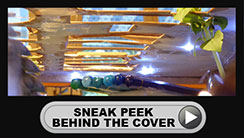
Photo by Deborah Berlinck
By Claire Doole, Claire Doole Communications
I know very little about classical music, but I was privileged to have a front row seat to a master class given by Gabor Takacs-Nagy. As I watched Takacs-Nagy in action, I realised much of what he said applied to public speaking – a world I know more about.
Takacs-Nagy, a renowned Hungarian violinist and conductor, is Director of the Verbier festival chamber orchestra. The festival, in the heart of the Alps, runs from 21st July to the 6th August, and is a key event in the classical music calendar.

Photo by Deborah Berlinck
So what does playing in public and speaking in public have in common?
Emotion is everything
Being a musician was like an emotional striptease explained Takacs-Nagy to aspiring professional musicians. The remark made the well-heeled audience laugh but resonated with me. Musicians he said needed to go beyond their technical prowess and convey the emotion of the work so that the audience connect emotionally.
It is the same principle in public speaking as Aristotle pointed out some 2500 years ago. If you want to persuade people, you have to not only have logos (facts) and ethos (credibility) but pathos (stirring the audience’s emotions).
The US author Maya Angelou goes even further: “I’ve learned that people will forget what you say, people will forget what you did, but people will never forget how you made them feel”.
Context is vital
Takacs-Nagy painted a vivid picture of what it was like to be a gypsy musician in the 18th century to help today’s young musicians convey the emotion of Brahm’s piano quartet number 1 in G minor, which is inspired by gypsy music.
A Masterclass by the Director of the Verbier Festival Chamber Orchestra from Claire Doole Communications on Vimeo.
If you are speaking in public the most effective way of getting a message across is to tell a personal story or anecdote. In both cases you need to explain the context – what is happening, where and when to whom, so that people care about the characters and the situation they find themselves in.
Show don’t tell
Tackacs-Nagy often picked up the violin and showed what he meant. He said he hadn’t played for many years so it was not about him showing off but helping the musicians hear what he meant.
In public speaking, it can be more powerful to describe a situation and let the audience form their own opinion, rather than telling them what to think. People in the professional world are often reluctant to show emotions as this can be seen as a sign of vulnerability. When I ask someone to share a personal story, I always share one first.
Light and shade
Too much emotion or too much of the same emotion is counterproductive as it will turn the audience off. Using the analogy of Da Vinci’s most famous painting, Tackacs-Nagy told the pianist playing Mozart’s piano quarter number 1 in G minor that he should see himself at certain moments more as the backdrop to the violinist’s Mona Lisa.
In public speaking it is vital that the speaker varies the emotional range – moving from “levitas” to “gravitas” to keep the audience interested, changing tone according to the message they are giving.

Photo by Deborah Berlinck
The Master Coach
As a media/public speaking coach, I know how important it is to have good intent when helping people through transformational change. Earlier this year, I went on a course where the sole intent of the trainer – a doyenne in the acting world – seemed to be to knock our confidence.
How refreshing to see in the equally competitive world of classical music, a coach whose constructive approach helped the musicians reach new heights of excellence, even to my untrained ear.

Photo by Deborah Berlinck
Author's bio
 Claire is a former BBC correspondent and international spokeswoman who is passionate about helping people communicate with confidence. Since 2006, she has successfully trained hundreds of professionals in the art of presenting and public speaking, talking to the media, managing communications in a crisis, and writing for the web. In addition, she has coached C-level executives and public figures to give powerful TEDx and TED style talks in Europe and the Middle East. A Swiss and UK national, Claire trains and coaches in French and English.
Claire is a former BBC correspondent and international spokeswoman who is passionate about helping people communicate with confidence. Since 2006, she has successfully trained hundreds of professionals in the art of presenting and public speaking, talking to the media, managing communications in a crisis, and writing for the web. In addition, she has coached C-level executives and public figures to give powerful TEDx and TED style talks in Europe and the Middle East. A Swiss and UK national, Claire trains and coaches in French and English.
Claire is also a highly experienced moderator having facilitated panel discussions with government ministers, NGO activists, humanitarians and human rights specialists at major events.









